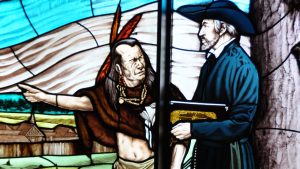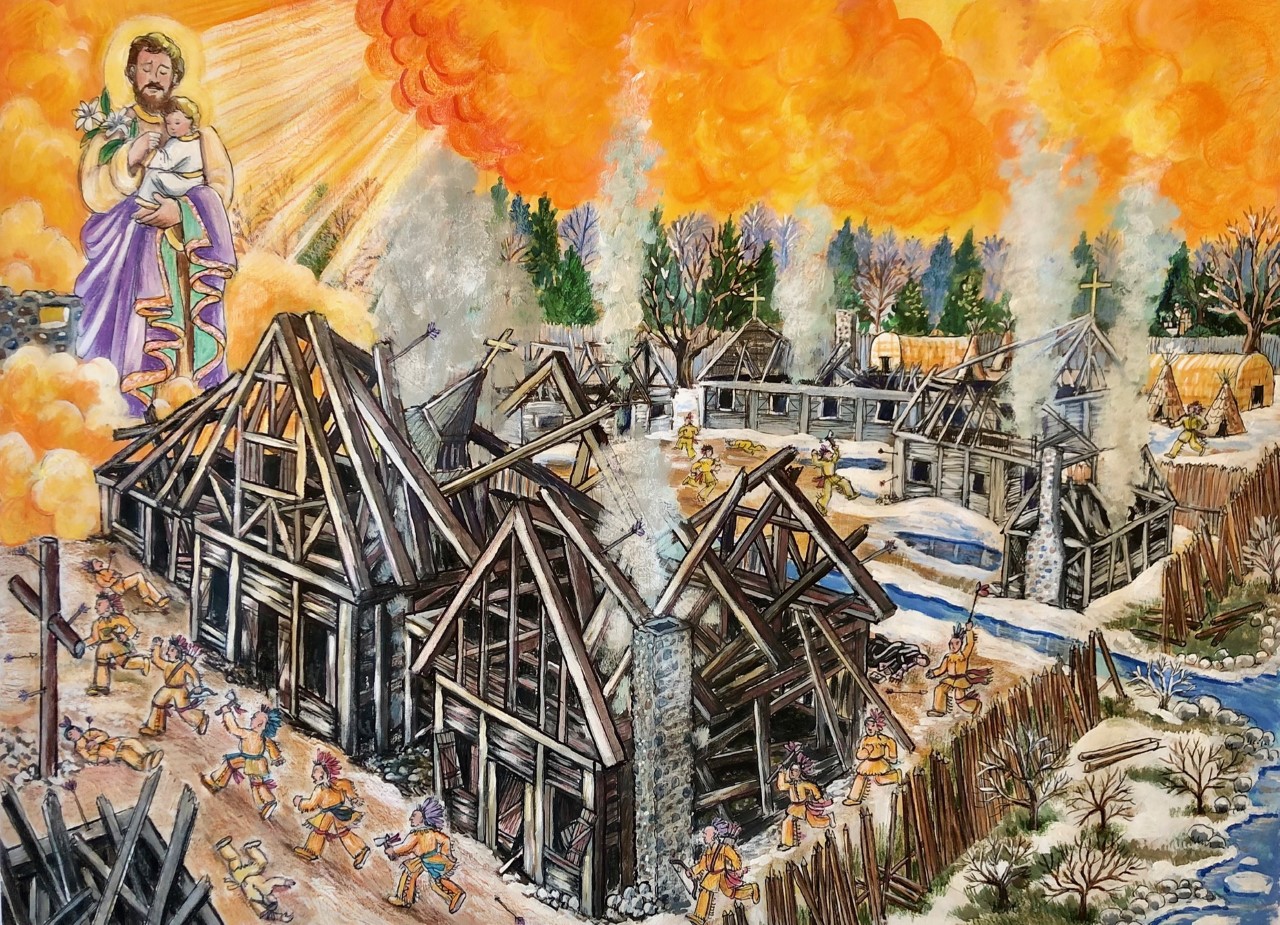Saint Joseph, protector of the missions
 Missions in Huronia:
Missions in Huronia:
In July 1634, Saint Jean de Brebeuf was sent by Father Lejeune near Lake Huron, in present-day Ontario, to establish a mission there. He became superior of the St. Joseph I mission, near Toanché, (a village where he spent 3 years, from 1626 to 1629). After a rather satisfactory period of evangelization, he encountered stubborn and growing resistance from the Hurons around 1637. According to Brébeuf, three factors explained this refusal: their attachment to their customs, their immorality and the epidemics. Indeed, with the prolonged contact between Amerindians and Europeans, several diseases from the Old World decimated part of the native population.
In 1638, Saint Jean de Brebeuf founded a new mission, Saint-Joseph II, in Teanaostaiae. After a new epidemic of smallpox, the Huron’s rage was even more intense and all kinds of violence (verbal and physical) were committed. Many converts denied their new faith. In the spring of 1640, the discontent turned into an uprising and the Jesuits were attacked: Pierre Boucher was wounded in the arm, while Brébeuf and Chaumonot were beaten. In May, Huron unrest prompted Lalemant to return to Québec.
In the fall of the same year, the missionaries decided to open two new missions: one among the Algonquins and another among a tribe called the Neutral. Fathers de Brebeuf and Chaumonot set out north of Lake Erie to try to convert the Neutral. The missionaries were preceded by Hurons who spread rumors about the Black Robes. The region they crossed was very hostile and everywhere they went they were rejected and reviled. It was five fruitless months. In the spring of 1641, while returning from the mission, Jean de Brebeuf broke his left collarbone while crossing a frozen lake. He was then sent back to Quebec.
 Iroquois attacks:
Iroquois attacks:
From Quebec City, Brebeuf had to organize expeditions to provide for the needs of the missionaries (paper, books, objects of worship, food…). In 1642 and 1643, the convoys he sent to Huronia were hijacked 3 times by Iroquois. The Iroquois/Huron conflict was getting so bad that it was less and less safe to travel from Quebec to Huronia. In fact, around 1647, the Hurons no longer went down to Quebec. At that time, the Dutch were arming the Iroquois with rifles, thus harassing the French and their allies to give up the colony.
On March 16, 1649, more than 1,000 Iroquois attacked the village of Saint-Ignace (Taenhatentaron), then the village of Saint-Louis, where Brébeuf and Lalemant were located. They were given the option of fleeing, but they preferred to stay and suffer the fate of their followers. They were captured and brought back to Saint-Ignace. There, they were greeted with rocks and insults. The details of the torture of Father Jean de Brebeuf were reported to us by Christophe Regnault, who observed and touched the remains of the religious. Fort Sainte-Marie, the last rampart of the French and Hurons, remained. On March 18, it was to be attacked by the victorious Iroquois.
Strong concerns in Quebec and in the other missions:
The fall of the missions in Huronia raised serious concerns in Quebec and in the other missions. All that remains is to turn to Heaven and implore the help of God and his saints. We redoubled our devotions,” wrote Father Ragueneau, “our help could only come from Heaven. Seeing ourselves on the eve of the feast of the glorious Saint Joseph, Patron of this country, we felt obliged to have recourse to such a powerful Protector. We vowed to say a monthly mass in his honor, for a whole year, for those who would be priests; and all of us, as many as there were people here, joined in various penances by vow.
“The whole day passed in profound silence on both sides, the country being in fear and in expectation of some new misfortune.
“On the nineteenth, the day of the great St. Joseph, a sudden fright fell upon the enemy camp, some withdrawing in disorder, others thinking only of fleeing. Their Captains were compelled to obey the terror that had seized them; they hastened their retreat.”

Following the departure of Fort Sainte-Marie, the following year, they took refuge on the island of Saint-Joseph and founded the mission that would also bear the name Saint-Joseph.
Sources :
www.tradition-quebec.ca/search/label/Histoire%20du%20Canada
www.pc.gc.ca/fr/lhn-nhs/qc/cartierbrebeuf/culture/Histoire-history/evenement-event/brebeuf/Huronie



